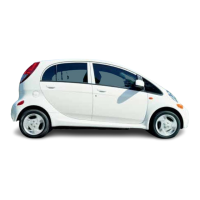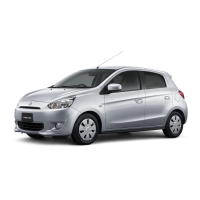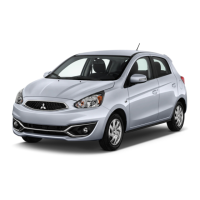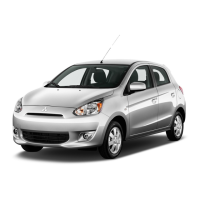Chapter 2 Part D General engine overhaul procedures
2D-19
14.4 The core plugs should be removed with a puller - if they’re
driven into the block, they may be impossible to retrieve
14.8 All bolt holes in the block - particularly the main bearing
cap and head bolt holes-should be cleaned and restored with a
tap (be sure to remove debris from the holes after this is done)
14.10 A large socket on an extension can be used to drive the
new core plugs into the bores
4 Check the main bearing caps to see if they’re marked to indic?te their
locations. They should be numbered consecutively from the front of the
engine to the rear. If they aren’t, mark them with number stamping dies or a
center punch (see illustrations). Main bearing caps generally have a
cast-in arrow, which points to the front of the engine (see illustration).
Loosen the main bearing cap bolts l/4-turn at a time each, until they can
be removed by hand. Note if any stud bolts are used and make sure they’re
returned to their original locations when the crankshaft is reinstalled.
5 Gently tap the caps with a soft-face hammer, then separate them from
the engine block. If necessary, use the bolts as levers to remove the caps.
Try not to drop the bearing inserts if they come out with the caps.
6 Carefully lift the crankshaft out of the engine. It may be a good idea to
have an assistant available, since the crankshaft is quite heavy. With the
bearing inserts in place in the engine block and main bearing caps, return
the caps to their respective locations on the engine block and tighten the
bolts finger tight.
14 Engine block - cleaning
engine block. Be very careful not to nick or gouge the gasket sealing sur-
faces.
3 Remove all of the covers and threaded oil gallery plugs from the block.
The plugs are usually very tight -they may have to be drilled out and the
holes retapped. Use new plugs when the engine is reassembled.
4 Drill a small hole in the center of each core plug and pull them out with
an auto body type dent puller (see illustration). Caution: The
coreplugs
-
(also known as freeze or soft plugs) may be difficult or impossible to re-
trieve if they’re driven into the block coolant passages.
5 If the engine is extremely dirty, it should be taken to an automotive ma-
chine shop to be steam cleaned or hot tanked.
6 Afterthe blockisreturned, clean alloil holesandoilgalleriesone more
time. Brushes specifically designed for this purpose are available at most
auto parts stores. Flush the passages with warm water until the water runs
clear, dry the block thoroughly and wipe all machined surfaceS with a light,
rust preventive oil. If you have access to compressed air, use it to speed
the drying process and blow out all the oil holes and galleries. Warning:
Wear eye protection when using compressed air!
7 lfthe blockisn’textremelydirtyorsludgedup, youcandoanadequate
cleaning job with hot soapy water and a stiff brush. Take plenty of time and
do a thorough job. Regardless of the cleaning ,method used, be sure to
clean all oil holes and galleries very thoroughly, dry the block completely
and coat all machined surfaces with light oil.
8 The threaded holes in the block must be clean to ensure accurate
torque readings during reassembly. Run the proper size tap into each of
the holes to remove rust, corrosion, thread sealant or sludge and restore
damaged threads (see illustration). If possible, use compressed air to
clear the holes of debris produced by this operation. Now is agood time to
clean the threads on the head bolts and the main bearing cap bolts as well.
9 Reinstall the main bearing caps and tighten the bolts finger tight.
10 After coating the sealing surfaces of the new core plugs with Perma-
tex nb. 2 sealant, install them in the engine block (see illustration). Make
sure they’re driven in straight and seated properly or leakage could result.
Special tools are available forthis purpose, but a large socket, with an out-
sidediameterthatwilljustslipinto thecoreplug, a l/2-inchdriveextension
and a hammer will work just as well.
11 Apply non-hardening sealant (?uch as Permatex no. 2 or Teflon pipe
sealant) to the new oil gallery plugs and thread them into the holes in the
block. Make sure they’re tightened securely.
12 If the engine isn’t going to be reassembled right away, cover it with a
large plastic trash bag to keep it clean.
Refer to illustrations 14.4, 14.8 and 14.10
1 Remove the main bearing caps and separate the bearing inserts from
the caps and the engine block. Tag the bearings, indicating which cylinder
they were removed from and whether they were in the cap or the block,
then set them aside.
2 Using a gasket scraper, remove all traces of gasket material from the
15 Engine block - Inspection
Refer to illustrations 15.4a, 15.4b and 15.4~
1 Before the block is inspected, it should be cleaned as described in
Section 14.

